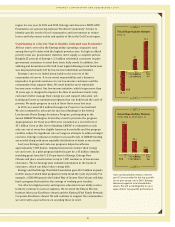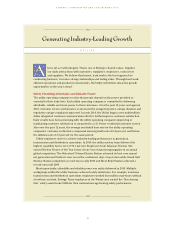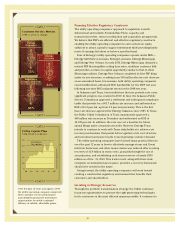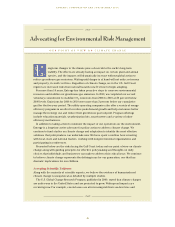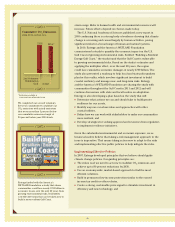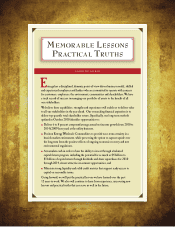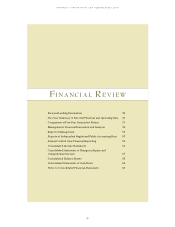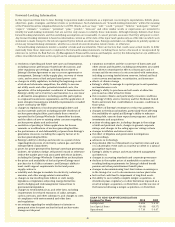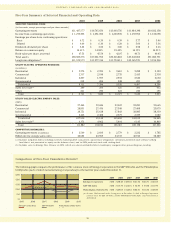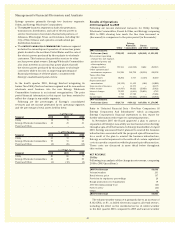Entergy 2010 Annual Report Download - page 24
Download and view the complete annual report
Please find page 24 of the 2010 Entergy annual report below. You can navigate through the pages in the report by either clicking on the pages listed below, or by using the keyword search tool below to find specific information within the annual report.
compared to 73 percent prior to Entergy ownership.
Higher capability factors imply greater generation
output and higher sustained value for the community
and shareholders. Production costs for the nuclear fl eet
were $25 per MWh, a decrease of 17 percent compared
to costs prior to Entergy ownership. EWC continues
to try to stabilize nuclear production costs, which are
subject to a number of upward pressures from fuel and
labor costs, and regulations.
Vermont Yankee employees worked tirelessly in
2010 to identify and fi x a detected tritium leak and
remediate its effects. The leak was identifi ed and
stopped in early 2010. Subsequently, contaminated soil
was removed and shipped out of the state of Vermont.
Recent test results, however, were positive for very
low levels of tritium at three monitoring wells outside
the previously affected area. Detectable levels of tritium
were not found at any time in drinking water samples
at or near the plant and based on rigorous Nuclear
Regulatory Commission and state standards, at these
low levels there is no threat to public health or safety.
The investigation into the test results is ongoing. Entergy
remains committed to becoming an industry leader in
tritium leak prevention, detection and mitigation; and
efforts under this fl eet-wide initiative are ongoing.
Preserving Vital Nuclear Assets
The operation of EWC nuclear assets is vital for the
local and state economies they support. Securing
license renewals at Pilgrim, Indian Point and Vermont
Yankee is a top priority. At all three plants, the NRC will
allow continued plant operation while its decision is
pending since Entergy fi led license renewal applications
more than fi ve years prior to the end of the current
license period. The status of the license renewal
process for each facility is as follows:
FOR PILGRIM
, the NRC’s Atomic Safety and Licensing
Board Panel hearing on one remaining contention is
scheduled for March 2011. The ASLB will also consider
whether to accept two new late-fi led contentions by
Pilgrim Watch. Additionally, EWC is currently preparing
supplements to the License Renewal Application
requested by the NRC. Pilgrim’s current operating
license expires in June 2012.
FOR INDIAN POINT UNITS 2 AND 3
, ASLB hearings are
estimated to begin in early 2012. A key state issue
regarding Indian Point’s license renewal relates to the
construction of cooling towers. EWC believes that
wedgewire screens, the Best Technology Available
alternative, are a much more cost-effective and practical
solution than cooling towers. Cooling towers are likely
not even permissible from an air quality standpoint
given non-attainment status in the area. Hearings
before Administrative Law Judges of the New York
State Department of Environmental Conservation are
scheduled to begin around mid-2011. Licenses for
Indian Point Units 2 and 3 expire in September 2013 and
December 2015, respectively.
FOR VERMONT YANKEE
,
in March 2011, the NRC said
that they expect Vermont Yankee’s renewed operating
license for an additional 20 years will be issued soon
. In
addition to its federal NRC license, there is a two-step
state-law licensing process for obtaining a Certifi cate
of Public Good to operate Vermont Yankee and store
spent nuclear fuel beyond March 21, 2012, when the
current CPG expires. First, the Vermont legislature must
vote affi rmatively to permit the Vermont Public Service
Board to consider Vermont Yankee’s application for a
renewed CPG for the continued operation of Vermont
Yankee and for storage of spent fuel. Second, the
Vermont Public Service Board must vote to renew the
CPG. EWC expects to have more clarity by mid-2011
on the open issues. The operating license for Vermont
Yankee expires in March 2012; a 20-year renewed
license would expire in March 2032.
These safe, clean nuclear generation assets are an
essential component of any realistic scenario to address
the future energy requirements of their service areas.
Managing Power Price Risk for EWC Nuclear
EWC pursues forward-contracting opportunities with
natural buyers and other participants who procure
large blocks of power on a long-term basis. Each year,
EWC layers in hedges as determined by its hedging
strategy and sets the pace of hedging, product choice
and surpassing of minimum limits based on its point
of view. While unit contingent contracts remain the
standard when they are economically available,
uncertainty related to license renewals at Pilgrim, Indian
Point and Vermont Yankee drove hedging actions in
2010 that included additional fi rm-liquidated damage
contracts and corresponding options to mitigate fi rm
settlement risk.
Northeast prices in the forward power market are
highly correlated to natural gas price movements, and
in 2010 natural gas prices continued to decline due
22





